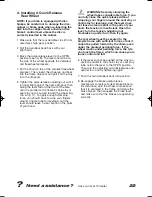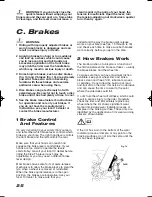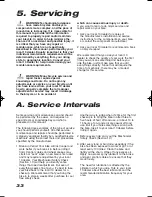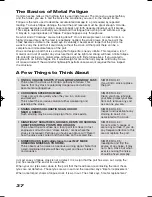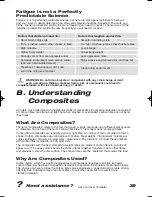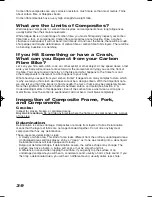
?
Need assistance?
Ask your
local 13 dealer
30
F. Bicycle Suspension
WARNING: Getting into and out of
pedals with toeclips and straps
requires skill which can only be acquired with
practice. Until it becomes a reflex action, this
technique requires concentration, which can
distract your attention and cause you to lose
control and fall. Practice the use of toeclips
and straps where there are no obstacles,
hazards or traffic. Keep the straps loose, and
don’t tighten them until your technique and
confidence in getting in and out of the pedals
warrants it. Never ride in traffic with your toe
straps tight.
4 Clipless pedals (sometimes called “SPD type
pedals”) are another means to keep feet
securely in the correct position for maximum
pedaling efficiency. They have a plate, called a
“cleat,” on the sole of the shoe, which clicks
into a mating spring-loaded fixture on the
pedal. They only engage or disengage with a
very specific motion, which must be practiced
until it becomes instinctive. Clipless pedals
require shoes and cleats, which are
compatible with the make and model of pedal
being used.
Many clipless pedals are designed to allow the
rider to adjust the amount of force needed to
engage or disengage the foot. Follow the
pedal manufacturer’s instructions, or ask your
local 13 dealer
to show you how to
make this
adjustment. Use the easiest setting
until
engaging and disengaging becomes a
reflex
action, but always make sure that there
is
sufficient tension to prevent unintended
release of your foot from the pedal.
WARNING: Clipless pedals are
intended for use with shoes
specifically made to fit them and are
designed to firmly keep the foot engaged
with the pedal. Using shoes which do not
engage the pedals correctly is dangerous.
Practice is required to learn to engage and
disengage the foot safely. Until engaging and
disengaging the foot becomes a reflex action, the
technique requires concentration which can
distract your attention and cause you to lose
control and fall. Practice engaging and
disengaging clipless pedals in a place where
there are no obstacles, hazards or traffic; and be
sure to follow the pedal manufacturer’s setup
and service instructions. If you do not have the
manufacturer’s instructions, see your
local 13
dealer
or contact the manufacturer.
Many bicycles are equipped with suspension
systems. There are many different types of
suspension systems – too many to deal with
individually in this Manual. If your bicycle has a
suspension system of any kind, be sure to read
and follow the suspension manufacturer’s setup
and service instructions. If you do not have the
manufacturer’s instructions, see your
local 13
dealer
or contact the manufacturer.
Winding a rear suspension spring tension nut
anti-clockwise will increase the travel of the rear
suspension, for a given load. However, never
reduce this pre-tension to such an extent that the
spring becomes loose when you lift the bike off
the ground.
Regularly inspect all suspension joints and
bushes for wear. If there is excessive play do
not ride the bicycle until that joint or bush has
been replaced.
WARNING: Failure to maintain, check
and properly adjust the suspension
system may result in suspension malfunction,
which may cause you to lose control and fall.
If your bike has suspension, the increased speed
you may develop also increases your risk of
injury. For example, when braking, the front of a
suspended bike dips. You could lose control and
fall if you do not have experience with this
system. Learn to handle your suspension system
safely. See also Section 4.C.
13
owners manual GENERIC A5 aw
05/05/14
10:25 Page 32







